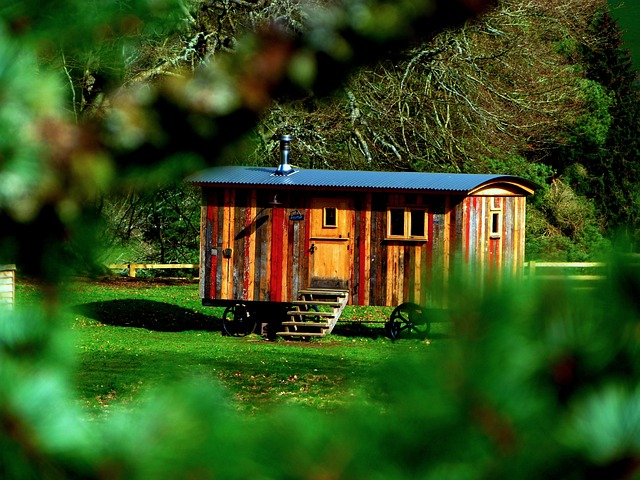Imagine the satisfying feeling of creating your own percussion instruments, tailored to your needs and budget.
In this article, experienced percussionist and instrument builder, Jim McCarthy, shares his passion for designing marimbas and demystifies the process of building your own instruments.
You don’t need to be a professional woodworker to embark on this fulfilling journey. With basic household tools and affordable materials, you can bring your musical dreams to life.
Get ready to unleash your creativity and discover the joy of making music with your very own homemade instruments.
Key Takeaways
 Building your own instruments is an affordable alternative to expensive commercial instruments.
Building your own instruments is an affordable alternative to expensive commercial instruments.- It is a fun and fulfilling project that can bring long-lasting joy.
- It is a cost-effective solution for schools needing classroom percussion ensembles.
- Basic woodworking skills are sufficient for building these instruments.
Benefits of Building Your Own Instruments
Building your own instruments offers a cost-effective solution for schools needing classroom percussion ensembles. It is a creative outlet that provides a cost-effective alternative to buying instruments.
By building your own instruments, you can save money while still having high-quality instruments for your students. Not only is it a practical solution, but it also allows for a unique and inventive approach to music education.
Building your own instruments can be an exciting and fulfilling project that sparks creativity and passion in both students and teachers. It enables you to customize the instruments to suit your needs and preferences, resulting in a personalized and distinctive sound.
Choosing the Right Instrument to Build
When selecting the instrument to construct, you should consider your personal preferences and musical goals. Choosing the right wood is crucial in creating an instrument that resonates with your unique sound. Different types of wood can produce different tones and characteristics, so take the time to research and find the wood that suits your desired sound.
Finding inspiration is also important in this process. Look for musicians who play the instrument you want to build and listen to their music. Immerse yourself in the sound and let it guide you in your construction journey.
Building your own instrument is not just a project, it’s an opportunity to create something truly special that reflects your passion for music. So, dive in, explore, and let your imagination run wild as you embark on this meticulous, inventive, and passionate journey of instrument building.
Getting Started: Materials and Tools
To get started, gather the necessary materials and tools for constructing your instrument.
Choosing the right materials is crucial to ensure the best sound quality and durability of your homemade instrument. Opt for various hardwoods for the bars, as special wood or metal is not required. Keep in mind that the type of timber you choose will affect the sound produced. Premium wood may yield a richer tone compared to cheaper alternatives.
As for essential tools, don’t worry about expensive or specialized equipment. Common household tools like an electric drill, screwdriver, wood saw, small hammer, and sandpaper are all you need. For specific instruments, a hacksaw and rivet gun may be necessary.
While tuning equipment is recommended, basic electronic tuners are affordable and can help you achieve professional results.
With the right materials and tools, your instrument building journey will be both meticulous and inventive, leading to a passion-filled and fulfilling experience.
Step-by-Step Guide to Building Your Instrument
Once you have gathered the necessary materials and tools, start by measuring and cutting the hardwood bars for your instrument. This step is crucial in achieving the perfect sound and resonance.
Make sure to choose the right plans that suit your skill level and desired instrument size. Take your time with the measurements, as precision is key. Cut the bars carefully, following the marked lines, and sand them down to a smooth finish.
As you progress through the construction process, you may encounter common problems like uneven sound or incorrect tuning. Don’t worry, troubleshooting is part of the journey. Experiment with different tuning techniques and consult online resources for guidance.
Building your own instrument is a meticulous, inventive, and passionate endeavor that will bring you immense joy and satisfaction.
Tips and Tricks for a Successful Build
Make sure you gather all the necessary materials and tools before starting the construction process for a successful build. Building your own instrument is an exciting endeavor that requires meticulous attention to detail.
As you embark on this journey, it’s important to be inventive and passionate about creating something truly unique. Troubleshooting common issues may arise, but with the right knowledge and care, you can overcome any obstacles.
Regular maintenance is crucial to keep your instrument in optimal condition. Simple tasks like cleaning the bars and tightening screws can go a long way in preserving the sound quality. Additionally, proper care includes storing the instrument in a dry environment and avoiding excessive temperature changes.
Personalizing Your Homemade Instrument
When personalizing your homemade instrument, you can choose from a variety of finishes and decorative elements to make it uniquely yours. The customizing options are endless, allowing you to add personal touches that reflect your creativity and style.
From vibrant paint colors to intricate wood carvings, you have the freedom to make your instrument a work of art. You can also explore different types of finishes like glossy varnish or matte stain to give it a professional look. Don’t forget about the details – consider adding personalized engravings or decals to truly make it one-of-a-kind.
Tuning and Fine-tuning Your Creation
To achieve the best sound quality, you can fine-tune your homemade instrument by adjusting the tension of the bars and using an electronic tuner for precise tuning.
Tuning techniques are crucial in achieving optimal sound and unleashing the full potential of your creation. By carefully adjusting the tension of the bars, you can ensure that each note resonates with clarity and precision.
The electronic tuner, a valuable tool in your arsenal, allows you to measure and adjust the pitch of each bar, ensuring that they are perfectly in tune. Take the time to experiment with different tensions and use the tuner to guide you towards the sweet spot.
With meticulous attention to detail and a passion for perfection, you can unlock the true beauty and resonance of your homemade instrument.
Showcasing Your Homemade Instrument
Once you have finished constructing your homemade instrument, you can proudly demonstrate its unique sound and craftsmanship to your friends and family. Showcasing your homemade instrument not only allows you to share your passion and creativity but also highlights the many benefits of building your own instruments.
These instruments serve as an affordable alternative to expensive commercial ones, making them accessible to all. They are perfect for percussion students or parents seeking practice instruments and provide a fun and fulfilling project that brings long-lasting joy.
Moreover, homemade instruments are a cost-effective solution for schools in need of classroom percussion ensembles. Whether you’re a student or a music enthusiast, showcasing your homemade instrument is a testament to the ingenuity and artistry that goes into creating something truly special.
Joining a Community of Instrument Builders
By joining a community of instrument builders, you can connect with fellow enthusiasts who share your passion for crafting unique musical instruments. This community provides a platform for finding inspiration and support as you embark on your instrument building journey.
Whether you are a seasoned builder or just starting out, being part of this community allows you to share your experiences, challenges, and triumphs with others who understand your dedication to the craft. You can exchange ideas, techniques, and resources, gaining valuable insights that can enhance your skills and knowledge.
The camaraderie and encouragement found within this community will fuel your passion and motivate you to push the boundaries of your creativity. So, don’t hesitate to join this vibrant community of instrument builders and experience the joy of sharing your instrument building journey with like-minded individuals.
Exploring Different Instrument Designs
Joining a community of instrument builders allows you to explore a wide variety of unique and innovative instrument designs. You’ll be amazed at the endless possibilities that exist when it comes to different instrument materials and the resulting unique instrument designs.
Whether you’re interested in constructing a marimba, xylophone, or vibraphone, the community of instrument builders will provide you with a wealth of knowledge and inspiration. Discover the beauty of using various hardwoods to create resonant and vibrant sounds. Embrace the opportunity to experiment with different designs, shapes, and sizes, allowing your creativity to flourish. From traditional to avant-garde, the possibilities are truly endless.
Joining this community will not only expand your understanding of instrument building but also provide you with a network of like-minded individuals who share your passion. So dive in, explore, and let your imagination soar as you embark on this incredible journey of building unique instruments.
Building Instruments for Educational Use
When constructing instruments for educational use, you’ll find that they are a cost-effective solution for schools needing percussion ensembles in the classroom. Not only are they affordable, but they also offer numerous benefits for beginners and music therapy.
Choosing the right instrument for beginners becomes easier with the option of building your own. Building instruments for music therapy can provide a personalized and therapeutic experience for individuals. It allows for creativity and customization, catering to the specific needs and preferences of the user. Building your own instruments can be a rewarding and fulfilling project, bringing joy and a sense of accomplishment.
Additionally, it offers a more budget-friendly option compared to purchasing pre-made instruments, making it accessible for schools and individuals with limited financial resources.
Long-term Satisfaction: Playing and Enjoying Your Homemade Instrument
Once you start playing your homemade instrument, you’ll experience the long-lasting joy and satisfaction that comes from creating your own music.
The beauty of building your own instrument is that you have the opportunity to customize it to your liking, ensuring that it fits your playing techniques perfectly.
Whether you’ve built a marimba, xylophone, or vibraphone, taking care of your instrument is crucial for maintaining its quality and longevity. Regular maintenance and care will ensure that your instrument continues to produce the beautiful tones you love.
Keep the bars clean and free from dust, oil the moving parts regularly, and store the instrument in a safe and dry place.
Frequently Asked Questions
Are There Any Safety Precautions to Keep in Mind While Building Your Own Instrument?
When building your own instrument, it’s important to prioritize safety. Take necessary safety measures and precautions to ensure a smooth and accident-free process.
Use tools and equipment properly, following instructions and guidelines. Wear protective gear, such as goggles and gloves, when necessary.
Keep work area clean and organized to prevent accidents. Prioritize your well-being and take the necessary steps to build your instrument safely and enjoyably.
How Long Does It Typically Take to Build a Homemade Instrument?
Building your own instrument is a labor of love, requiring patience, precision, and passion. It’s like crafting a melody from scratch, each step adding a unique note to the symphony of creation.
The time it takes to build a homemade instrument varies depending on the complexity and your skill level, but with the right materials and a step-by-step tutorial, you’ll be well on your way.
Can I Customize the Size or Design of the Instrument I Want to Build?
Yes, you can definitely customize the size and design of the instrument you want to build. Building your own instrument gives you the freedom to create something unique and tailored to your preferences.
You can choose the dimensions that suit your playing style and aesthetic taste. When it comes to materials, it’s important to consider the sound quality you desire. Different woods produce different tones, so selecting the right timber is crucial for achieving the desired sound.
Are There Any Specific Maintenance Requirements for Homemade Instruments?
Maintenance tips for homemade instruments include:
- Regular cleaning
- Tightening screws
- Checking for any signs of wear or damage
It is recommended to store the instruments in a dry and temperature-controlled environment to prevent warping or cracking.
As for tools, you’ll need common household items like a screwdriver and sandpaper. Additionally, a wood saw and small hammer are useful for repairs.
Remember to be meticulous and passionate in taking care of your instrument to ensure its longevity and optimal performance.
Can I Build a Percussion Instrument Even if I Have No Prior Musical Experience?
Yes, you can absolutely build a percussion instrument even if you have no prior musical experience. There are beginner-friendly percussion instrument options available that require basic woodworking skills.
You don’t need special materials for the bars, as instruments can be made from various hardwoods. The cost of materials will depend on the instrument you choose to build.
With common household tools like an electric drill and screwdriver, you can embark on this fulfilling and creative journey of building your own percussion instrument.
Conclusion
Now, armed with the knowledge and inspiration you’ve gained, you’re ready to embark on your own instrument-building journey.
It may seem ironic, but by building your own instruments, you can actually save money and create high-quality percussion pieces. Who would have thought? So don’t let the idea of not being a professional woodworker stop you.
With basic tools and a passion for creating music, you can build an instrument that will bring you endless joy and satisfaction. So go ahead, let your creativity flourish, and start building your own instrument today!

 Building your own instruments is an affordable alternative to expensive commercial instruments.
Building your own instruments is an affordable alternative to expensive commercial instruments.






